Bài giảng Introduction to Software Engineering - Week 3: Project management - Nguyễn Thị Minh Tuyền
Concerned with activities involved in
p ensuring that software is delivered on time and on
schedule and
p accordance with the requirements of the organisations
developing and
p procuring the software.
£ Is needed because .
p software development is always subject to budget and
schedule constraints that are set by the organisation
developing the software.
£ Good management cannot guarantee project success.
However, bad management usually results in project
failure.
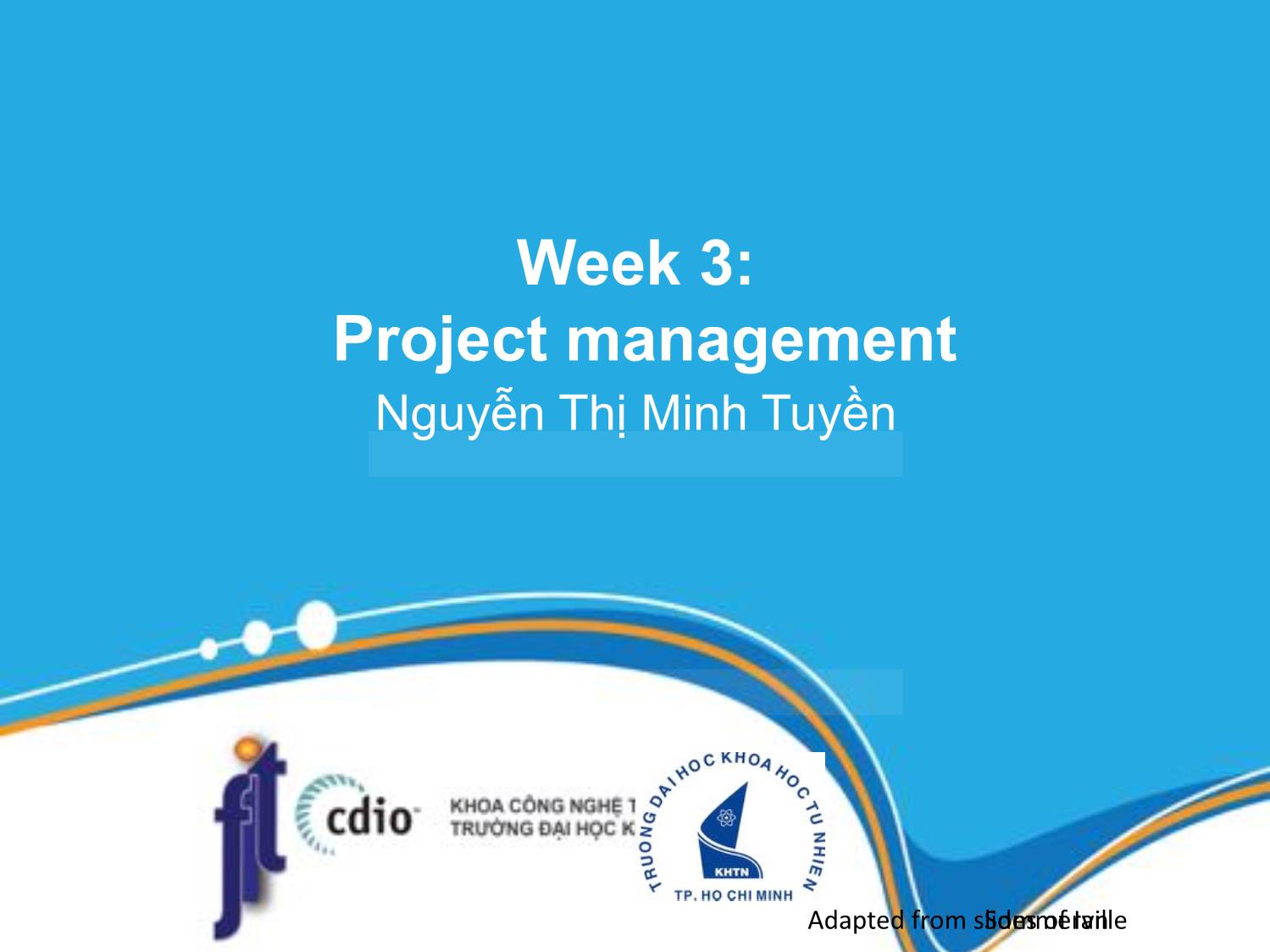
Trang 1
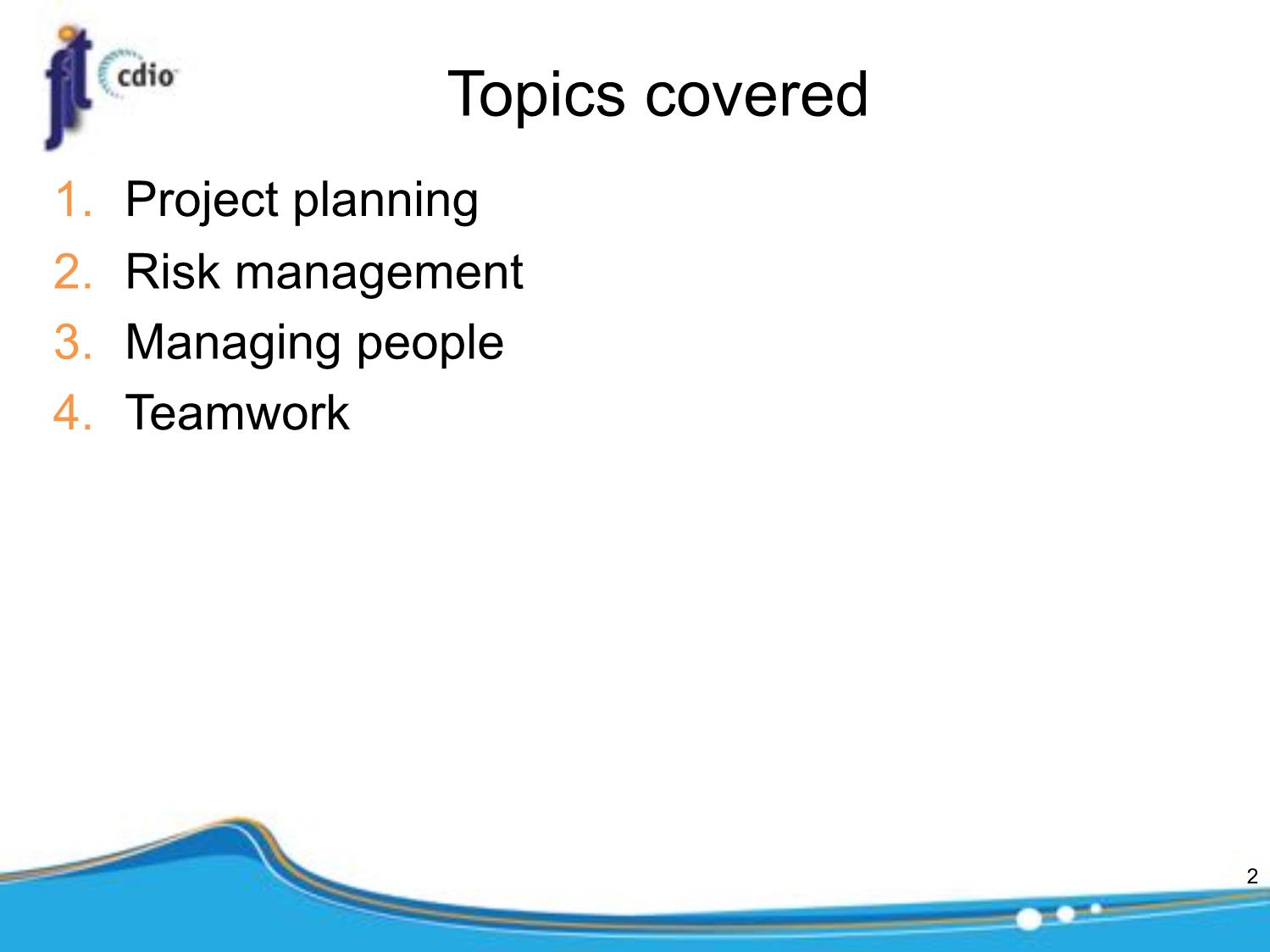
Trang 2
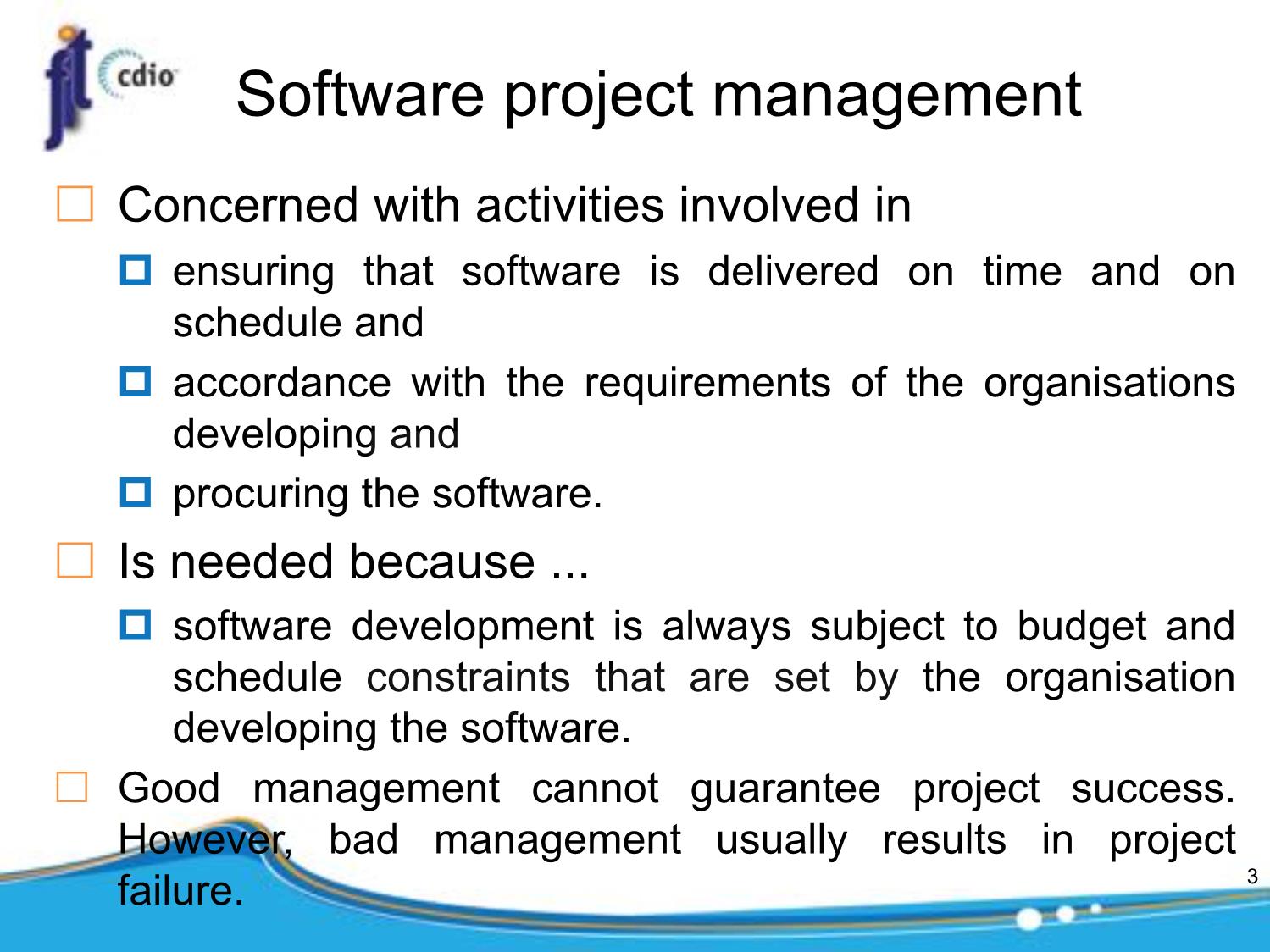
Trang 3
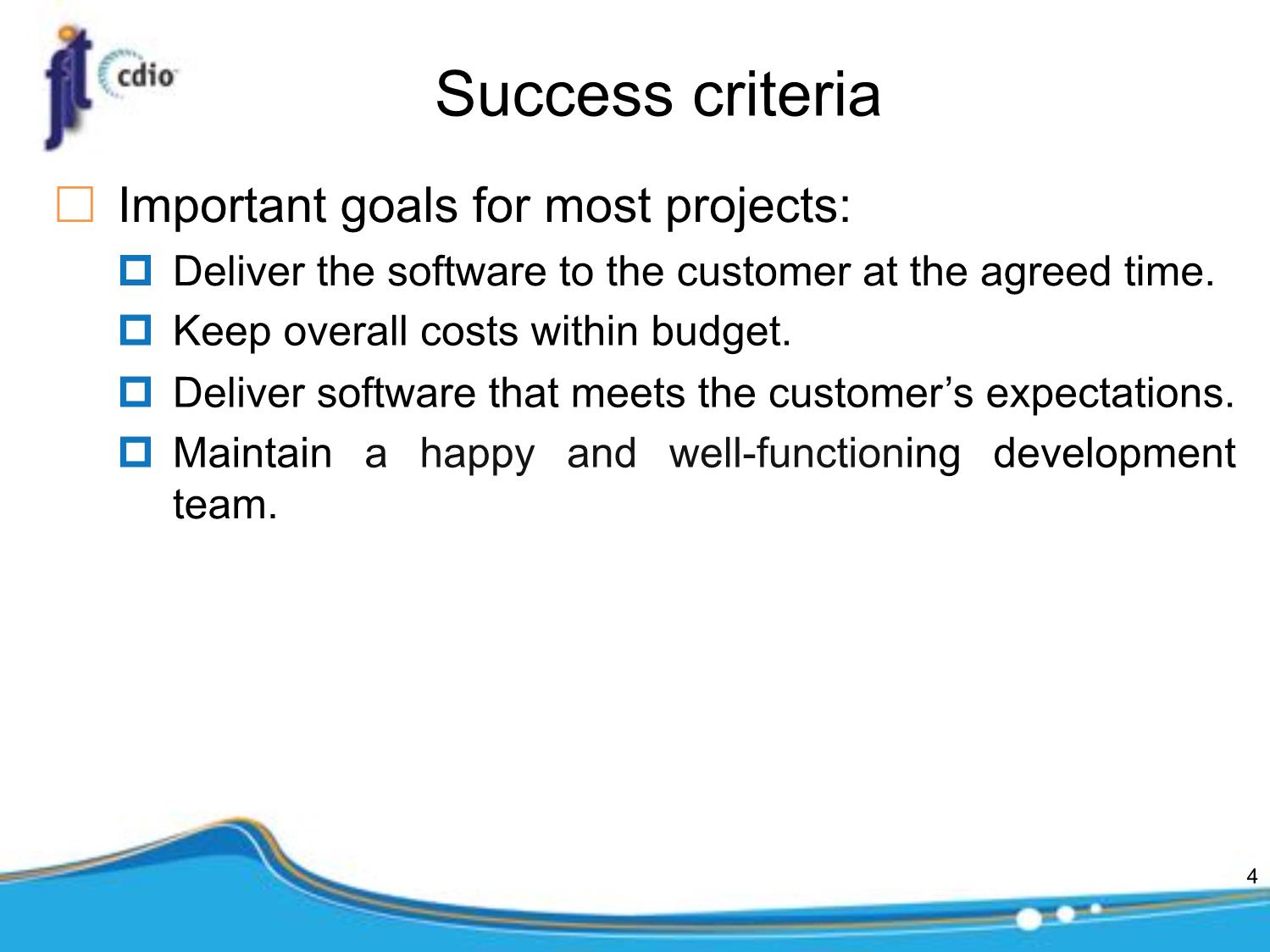
Trang 4
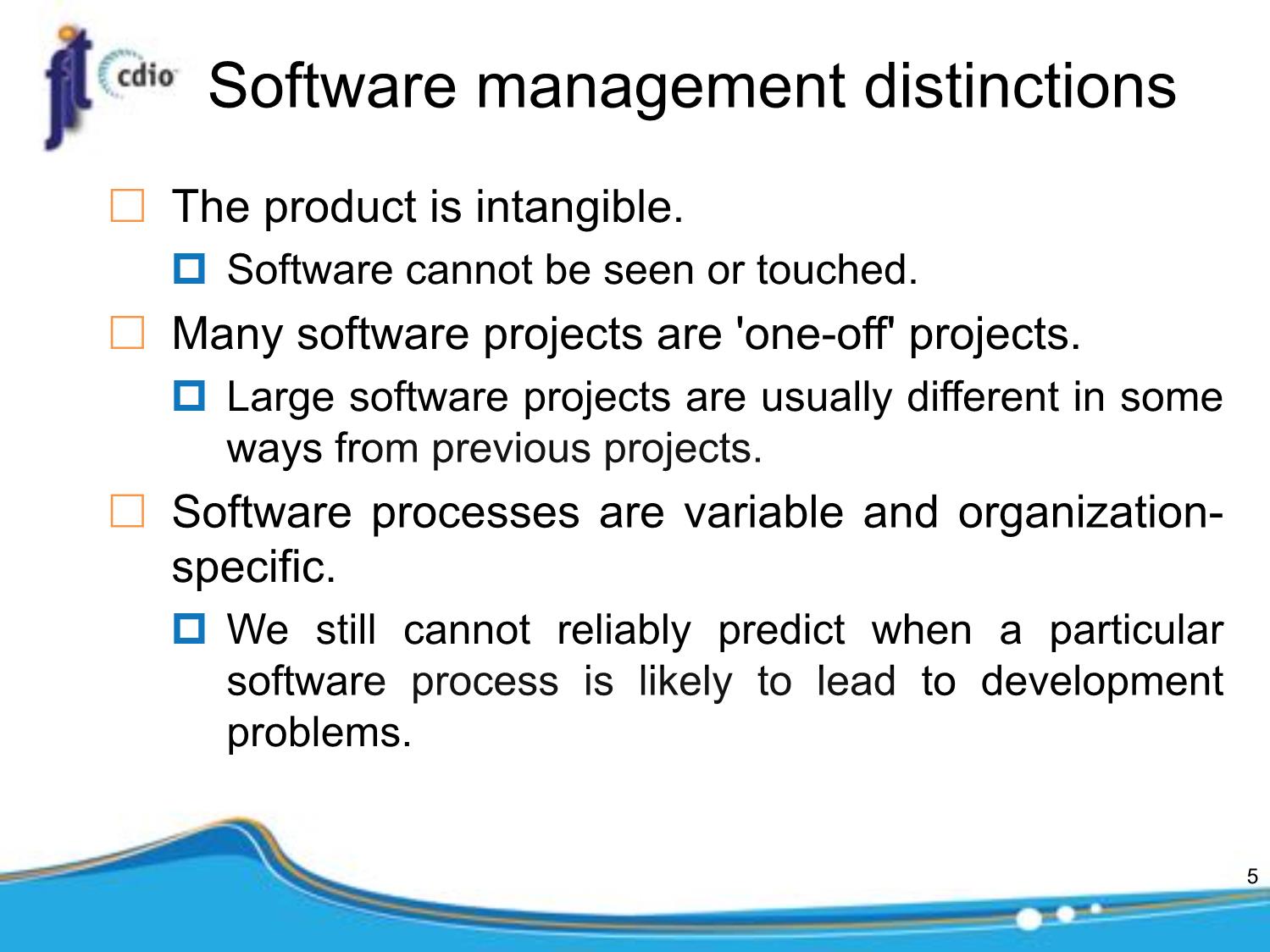
Trang 5
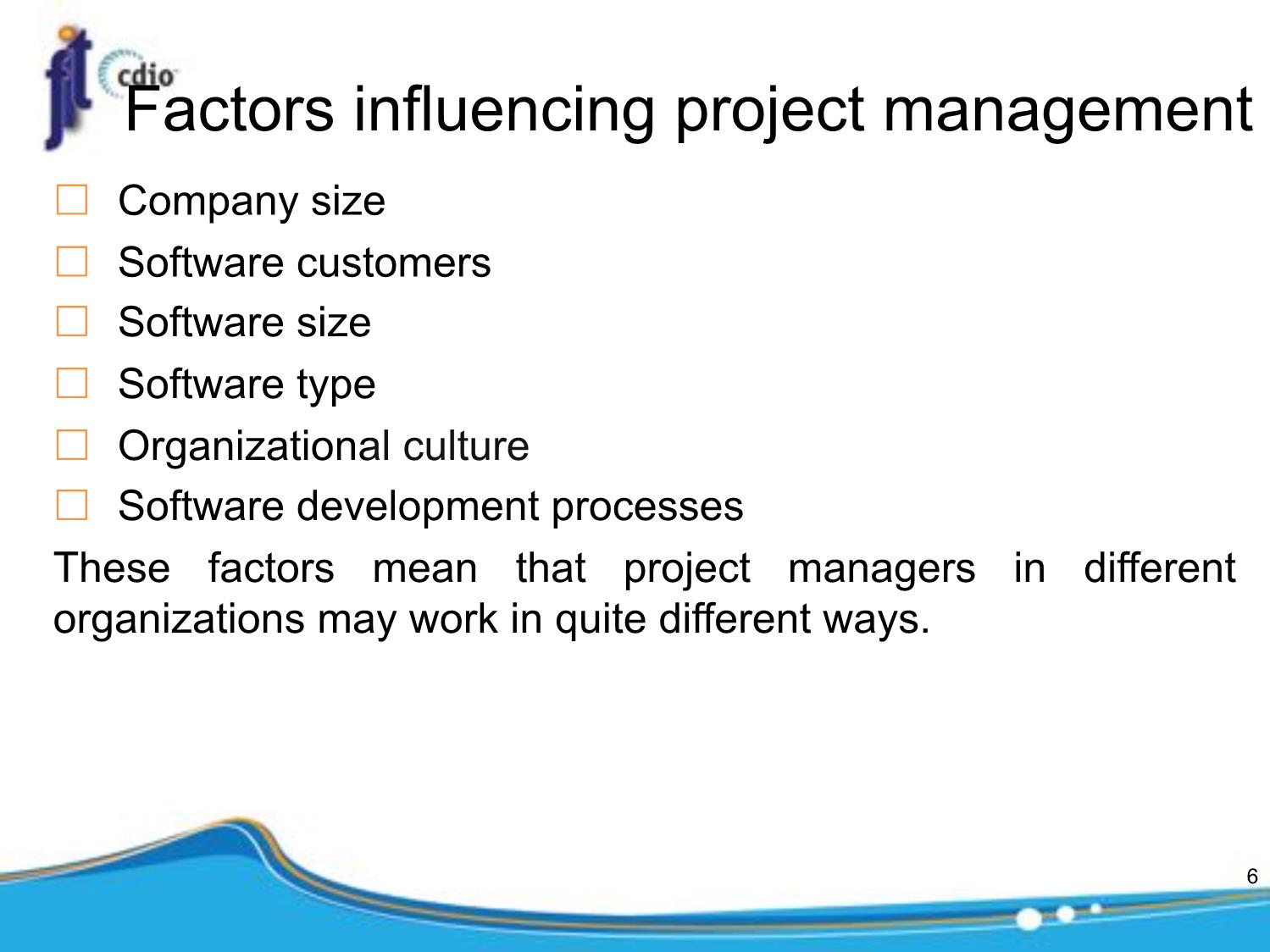
Trang 6
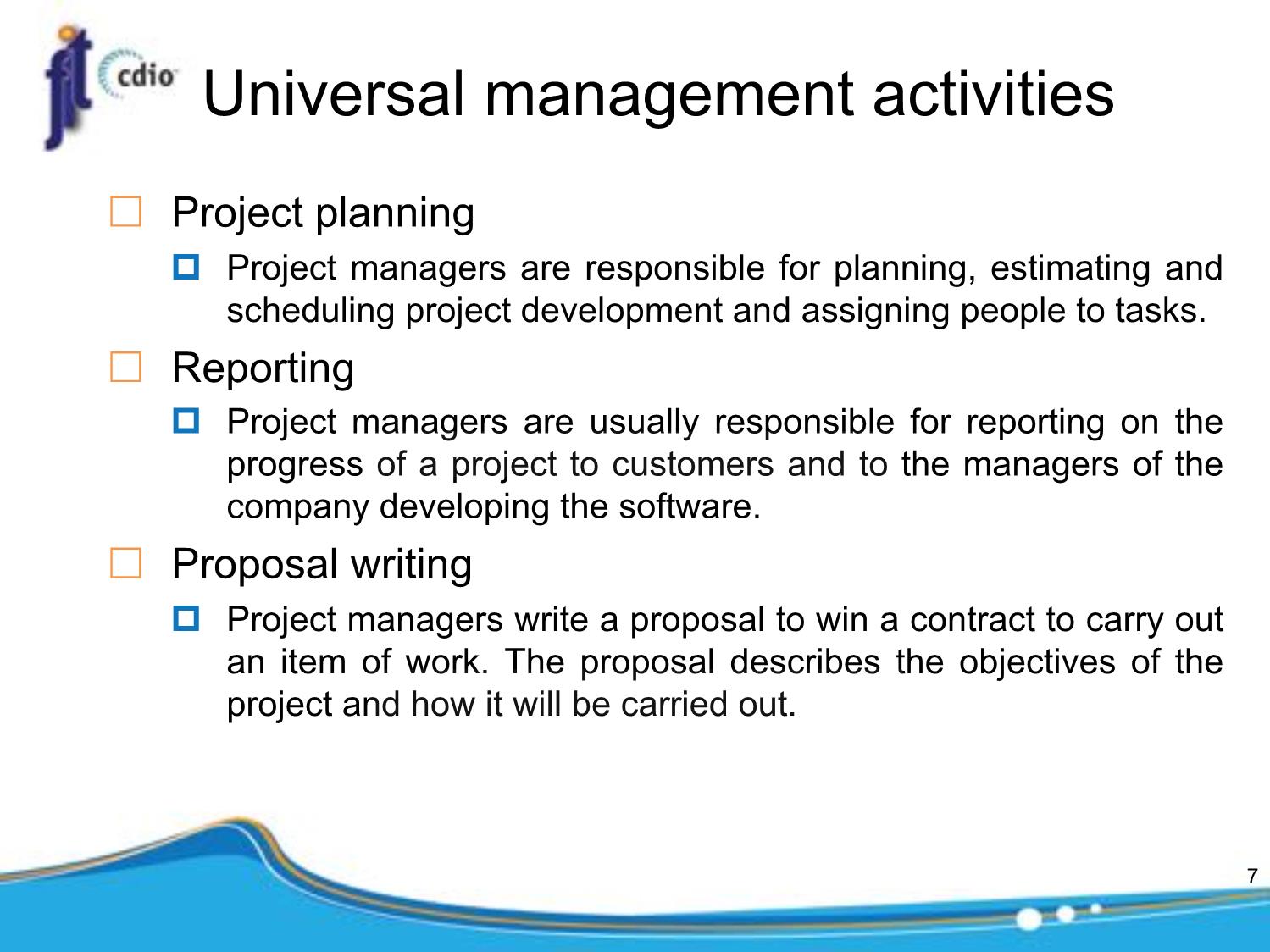
Trang 7
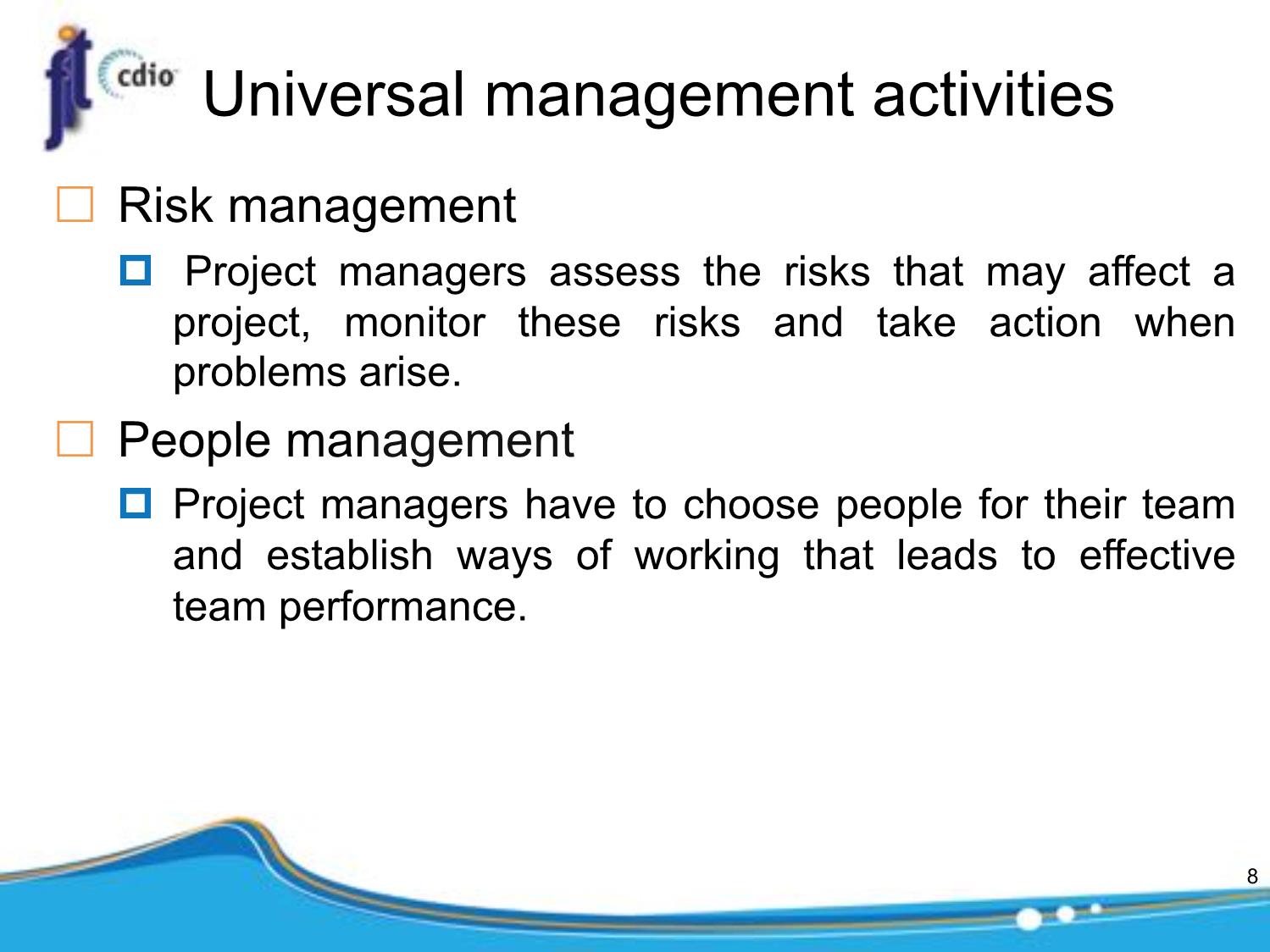
Trang 8
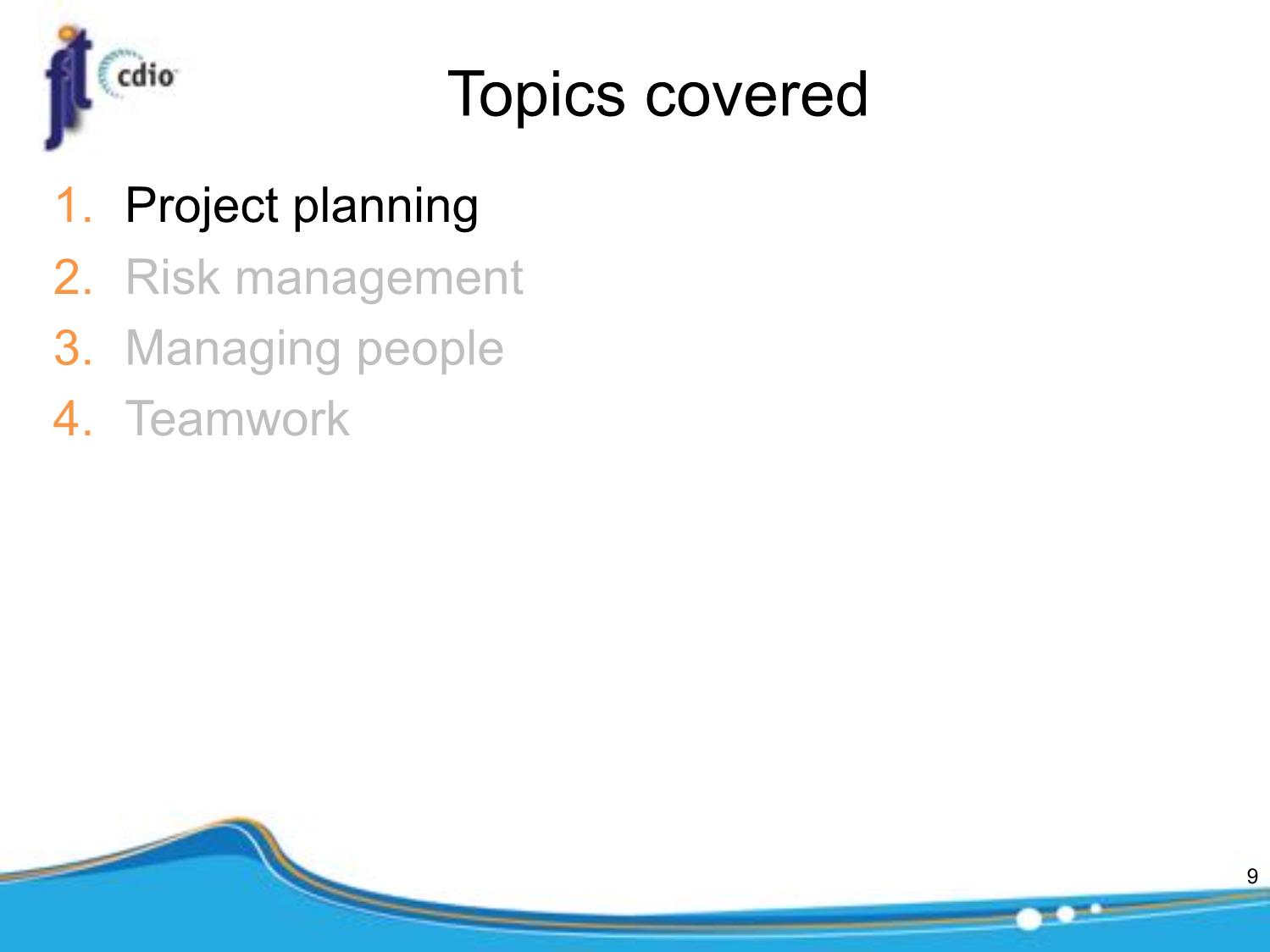
Trang 9
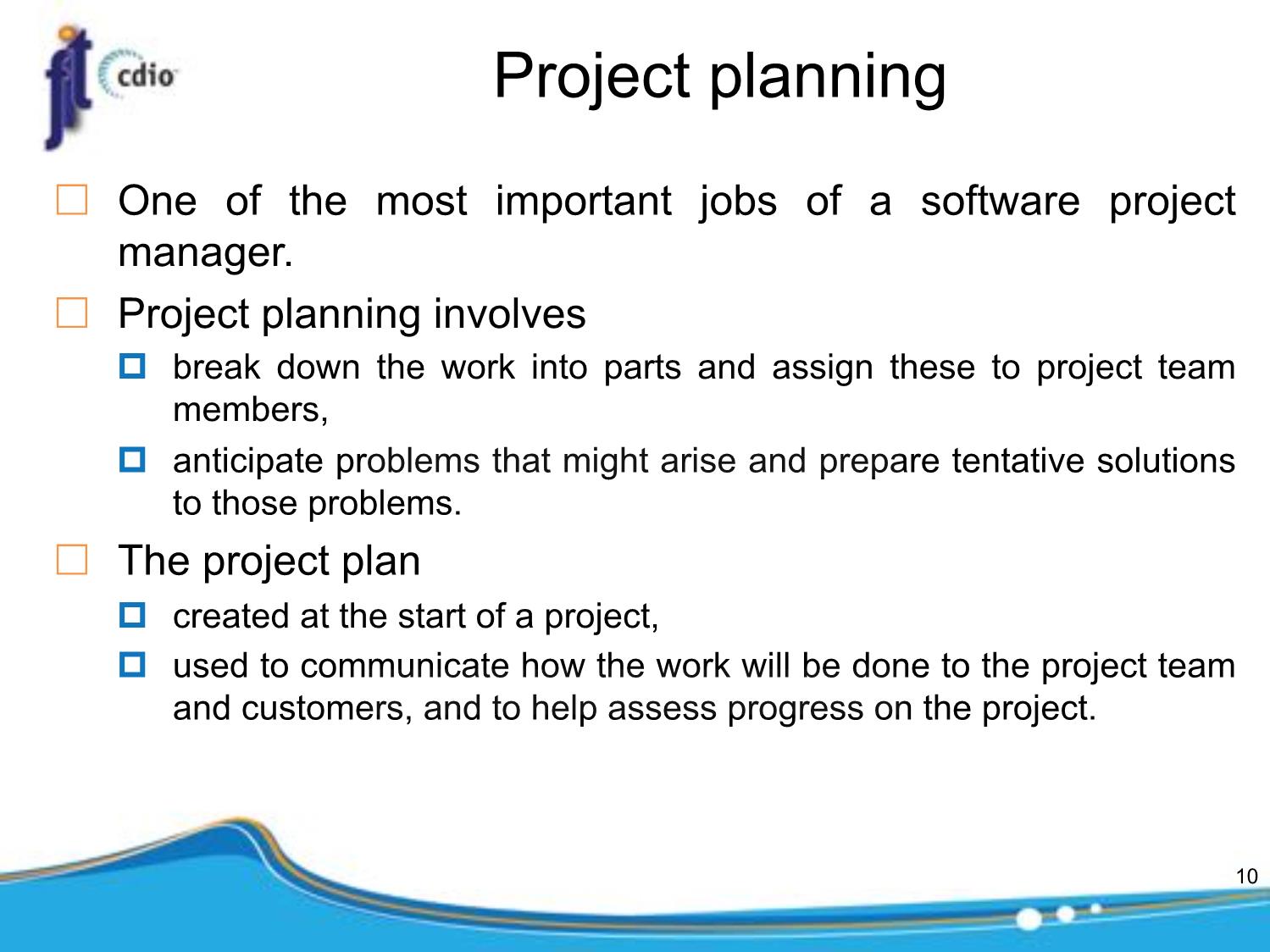
Trang 10
Tải về để xem bản đầy đủ
Bạn đang xem 10 trang mẫu của tài liệu "Bài giảng Introduction to Software Engineering - Week 3: Project management - Nguyễn Thị Minh Tuyền", để tải tài liệu gốc về máy hãy click vào nút Download ở trên
Tóm tắt nội dung tài liệu: Bài giảng Introduction to Software Engineering - Week 3: Project management - Nguyễn Thị Minh Tuyền
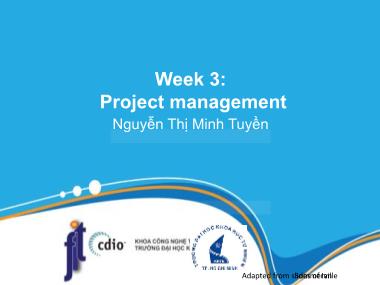
sk management process £ Risk identification p Identify project, product and business risks; £ Risk analysis p Assess the likelihood and consequences of these risks; £ Risk planning p Draw up plans to avoid or minimise the effects of the risk; £ Risk monitoring p Monitor the risks throughout the project; 34 Risk management process Risk Risk Risk Risk identification analysis planning monitoring Risk avoidance List of potential Prioritized risk Risk and contingency risks list assessment plans 35 Risk identification £ May be a team activities or based on the individual project manager’s experience. £ A checklist of common risks may be used to identify risks in a project p Technology risks. p People risks. p Organisational risks. p Tools risks. p Requirements risks. p Estimation risks. 36 Examples of different risk types Risk type Possible risks Technology The database used in the system cannot process as many transactions per second as expected. (1) Reusable software components contain defects that mean they cannot be reused as planned. (2) People It is impossible to recruit staff with the skills required. (3) Key staff are ill and unavailable at critical times. (4) Required training for staff is not available. (5) Organizational The organization is restructured so that different management are responsible for the project. (6) Organizational financial problems force reductions in the project budget. (7) Tools The code generated by software code generation tools is inefficient. (8) Software tools cannot work together in an integrated way. (9) Requirements Changes to requirements that require major design rework are proposed. (10) Customers fail to understand the impact of requirements changes. (11) Estimation The time required to develop the software is underestimated. (12) The rate of defect repair is underestimated. (13) The size of the software is underestimated. (14) 37 Risk analysis £ Assess probability and seriousness of each risk. £ Probability may be very low, low, moderate, high or very high. £ Risk consequences might be catastrophic, serious, tolerable or insignificant. 38 Risk types and examples Risk Probability Effects Organizational financial problems force reductions in the Low Catastrophic project budget (7). It is impossible to recruit staff with the skills required for the High Catastrophic project (3). Key staff are ill at critical times in the project (4). Moderate Serious Faults in reusable software components have to be Moderate Serious repaired before these components are reused. (2). Changes to requirements that require major design rework Moderate Serious are proposed (10). The organization is restructured so that different High Serious management are responsible for the project (6). The database used in the system cannot process as many Moderate Serious transactions per second as expected (1). 39 Risk types and examples Risk Probability Effects The time required to develop the software is High Serious underestimated (12). Software tools cannot be integrated (9). High Tolerable Customers fail to understand the impact of Moderate Tolerable requirements changes (11). Required training for staff is not available (5). Moderate Tolerable The rate of defect repair is underestimated (13). Moderate Tolerable The size of the software is underestimated (14). High Tolerable Code generated by code generation tools is inefficient Moderate Insignificant (8). 40 What-if questions £ What if several engineers are ill at the same time? £ What if an economic downturn leads to budget cuts of 20% for the project? £ What if the performance of open-source software is inadequate and the only expert on that open source software leaves? £ What if the company that supplies and maintains software components goes out of business? £ What if the customer fails to deliver the revised requirements as predicted? 41 Risk planning £ Consider each risk and develop a strategy to manage that risk. £ Avoidance strategies p The probability that the risk will arise is reduced; £ Minimisation strategies p The impact of the risk on the project or product will be reduced; £ Contingency plans p If the risk arises, contingency plans are plans to deal with that risk; 42 Strategies to help manage risk Risk Strategy Organizational Prepare a briefing document for senior management financial problems showing how the project is making a very important contribution to the goals of the business and presenting reasons why cuts to the project budget would not be cost-effective. Recruitment problems Alert customer to potential difficulties and the possibility of delays; investigate buying-in components. Staff illness Reorganize team so that there is more overlap of work and people therefore understand each other’s jobs. Defective Replace potentially defective components with bought- components in components of known reliability. Requirements Derive traceability information to assess requirements changes change impact; maximize information hiding in the design. 43 Strategies to help manage risk Risk Strategy Organizational Prepare a briefing document for senior management restructuring showing how the project is making a very important contribution to the goals of the business. Database Investigate the possibility of buying a higher- performance performance database. Underestimated Investigate buying-in components; investigate use of development time a program generator. 44 Risk monitoring £ Assess each identified risks regularly to decide whether or not it is becoming less or more probable. £ Also assess whether the effects of the risk have changed. £ Each key risk should be discussed at management progress meetings. 45 Risk indicators Risk type Potential indicators Technology Late delivery of hardware or support software; many reported technology problems. People Poor staff morale; poor relationships amongst team members; high staff turnover. Organizational Organizational gossip; lack of action by senior management. Tools Reluctance by team members to use tools; complaints about CASE tools; demands for higher-powered workstations. Requirements Many requirements change requests; customer complaints. Estimation Failure to meet agreed schedule; failure to clear reported defects. 46 Topics covered 1. Risk management 2. Managing people 3. Teamwork 47 Managing people £ People are an organisation’s most important assets. £ The tasks of a manager are essentially people- oriented. Unless there is some understanding of people, management will be unsuccessful. £ Poor people management is an important contributor to project failure. People management factors £ Consistency p Team members should all be treated in a comparable way without favourites or discrimination. £ Respect p Different team members have different skills and these differences should be respected. £ Inclusion p Involve all team members and make sure that people’s views are considered. £ Honesty p You should always be honest about what is going well and what is going badly in a project. Motivating people £ An important role of a manager is to motivate the people working on a project. £ Means organizing the work and the working environment to encourage people to work effectively. p If people are not motivated, they will not be interested in the work they are doing. They will work slowly, be more likely to make mistakes and will not contribute to the broader goals of the team or the organization. £ Is a complex issue but it appears that their are different types of motivation based on: p Basic needs (e.g. food, sleep, etc.); p Personal needs (e.g. respect, self-esteem); 50 p Social needs (e.g. to be acceptedas part of a group). Human needs hierarchy Self- realization needs Esteem needs Social needs Safety needs Physiological needs 51 Need satisfaction £ In software development groups, basic physiological and safety needs are not an issue. £ Social p Provide communal facilities; p Allow informal communications e.g. via social networking £ Esteem p Recognition of achievements; p Appropriate rewards. £ Self-realization p Training - people want to learn more; p Responsibility. 52 Personality types £ The needs hierarchy is almost certainly an over- simplification of motivation in practice. £ Motivation should also take into account different personality types: p Task-oriented; p Self-oriented; p Interaction-oriented. 53 Personality types £ Task-oriented. p The motivation for doing the work is the work itself; £ Self-oriented. p The work is a means to an end which is the achievement of individual goals - e.g. to get rich, to play tennis, to travel etc.; £ Interaction-oriented p The principal motivation is the presence and actions of co-workers. People go to work because they like to go to work. 54 Motivation balance £ Individual motivations are made up of elements of each class. £ The balance can change depending on personal circumstances and external events. £ However, people are not just motivated by personal factors but also by being part of a group and culture. £ People go to work because they are motivated by the people that they work with. 55 Topics covered 1. Risk management 2. Managing people 3. Teamwork 56 Teamwork £ Most software engineering is a group activity p The development schedule for most non-trivial software projects is such that they cannot be completed by one person working alone. £ A good group is cohesive and has a team spirit. p The people involved are motivated by the success of the group as well as by their own personal goals. £ Group interaction is a key determinant of group performance. £ Flexibility in group composition is limited p Managers must do the best they can with available people. 57 Group cohesiveness £ In a cohesive group, members consider the group to be more important than any individual in it. £ The advantages of a cohesive group are: p Group quality standards can be developed by the group members. p Team members learn from each other and get to know each other’s work; Inhibitions caused by ignorance are reduced. p Knowledge is shared. Continuity can be maintained if a group member leaves. p Refactoring and continual improvement is encouraged. Group members work collectively to deliver high quality results and fix problems, irrespective of the individuals who originally created the design or program. Effectiveness of a team £ The people in the group p You need a mix of people in a project group as software development involves diverse activities such as negotiating with clients, programming, testing and documentation. £ The group organization p A group should be organized so that individuals can contribute to the best of their abilities and tasks can be completed as expected. £ Technical and managerial communications p Good communications between group members, and between the software engineering team and other 59 project stakeholders, is essential. Selecting group members £ A manager or team leader’s job is to create a cohesive group and organize their group so that they can work together effectively. £ This involves creating a group with the right balance of technical skills and personalities, and organizing that group so that the members work together effectively. 60 Assembling a team £ May not be possible to appoint the ideal people to work on a project p Project budget may not allow for the use of highly-paid staff; p Staff with the appropriate experience may not be available; p An organisation may wish to develop employee skills on a software project. £ Managers have to work within these constraints especially when there are shortages of trained staff. 61 Group composition £ Group composed of members who share the same motivation can be problematic p Task-oriented - everyone wants to do their own thing; p Self-oriented - everyone wants to be the boss; p Interaction-oriented - too much chatting, not enough work. £ An effective group has a balance of all types. £ This can be difficult to achieve software engineers are often task-oriented. £ Interaction-oriented people are very important as they can detect and defusetensions that 62 arise. Group organization £ The way that a group is organized affects p the decisions that are made by that group, p the ways that information is exchanged and p the interactions between the development group and external project stakeholders. £ Key questions include: p Should the project manager be the technical leader of the group? p Who will be involved in making critical technical decisions, and how will these be made? p How will interactions with external stakeholders and senior company management be handled? p How can groups integrate people who are not co-located? 63 p How can knowledge be shared acrossgroup?the Group organization £ Small software engineering groups are usually organised informally without a rigid structure. £ For large projects, there may be a hierarchical structure where different groups are responsible for different sub-projects. £ Agile development is always based around an informal group on the principle that formal structure inhibits information exchange 64 Informal groups £ The group acts as a whole and comes to a consensus on decisions affecting the system. £ The group leader serves as the external interface of the group but does not allocate specific work items. £ Rather, work is discussed by the group as a whole and tasks are allocated according to ability and experience. £ This approach is successful for groups where all members are experienced and competent. 65 Group communications £ Good communications are essential for effective group working. £ Information must be exchanged on the status of work, design decisions and changes to previous decisions. £ Good communications also strengthens group cohesion as it promotes understanding. 66 Group communications £ Group size p The larger the group, the harder it is for people to communicate with other group members. £ Group structure p Communication is better in informally structured groups than in hierarchically structured groups. £ Group composition p Communication is better when there are different personality types in a group and when groups are mixed rather than single sex. £ The physical work environment p Good workplace organisation can help encourage communications. 67 Questions? 68
File đính kèm:
 bai_giang_introduction_to_software_engineering_week_3_projec.pdf
bai_giang_introduction_to_software_engineering_week_3_projec.pdf

